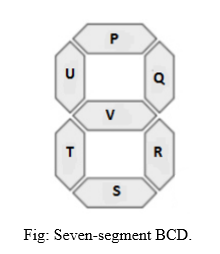Binary Coded Decimal Seven Segment Circuit Designing using Quantum dot Cellular Automata
Also Available Domains Arithmetic Core
Abstract
Quantum-dot Cellular Automata (QCA) is a new due to making significant improvements in the design of electronic circuits can be considered as an appropriate alternative to CMOS. technology. It is an alternative nanotechnology that keeps scaling down. The technology is further It can do scaling beyond to a level where complementary Metal oxide semiconductor (CMOS) scaling is the issue. QCA is seen as an emerging solutions for nano-architectures.
In our work, seven Segment Display is proposed using different gates and majority voters in QCA. This nanotechnology uses different logic devices for digital circuit designing. for obtaining a high rate of performance at output. This new nanotechnology It uses a specific method to represent and decode the data. The main aim of the Our work is to understand the basic QCA technology and to get familiar with the QCA designer software for getting involved in the advanced designing of digital circuits using QCA. In our work, Seven Segment Display is proposed using different gates and majority voters in QCA. A seven-segment display uses light. to display output that can be in the form of an image, text or a decimal number. The simulation results verify that our work is significant.
Keywords: Quantum-dot Cellular Automata (QCA), seven-segment display, arithmetic Logic Unit (ALU), CMOS, and QCA Designer.
NOTE: Without the concern of our team, please don't submit to the college. This Abstract varies based on student requirements.
Block Diagram

Specifications
Software Requirements:
· QCA Designer Tool
Hardware Requirements:
· Microsoft® Windows XP
· Intel® Pentium® 4 processor or Pentium 4 equivalent with SSE support.
· 512 MB of RAM
· 100 MB of available disk space
Learning Outcomes
- The Basics of Digital Electronics
- VLSI Design Flow
- An Introduction to Quantum Dot Cellular automata (QCA)
- Creating designs in QCA The Designer tool
- Introduction to Combinational short circuits.
- Knowledge in seven segments on display.
- Applications in real time
- QCA Designer for design and simulation
- Solution providing for real time problems
- Project Development Skills:
o Problem Analysis Skills
o Problem Solving Skills
o Logical Skills
o Designing Skills
o Testing Skills
o Debugging Skills
o Presentation Skills
o Thesis Writing Skills


 Paper Publishing
Paper Publishing
